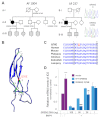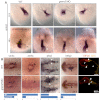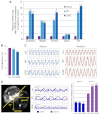Functional modeling in zebrafish demonstrates that the atrial-fibrillation-associated gene GREM2 regulates cardiac laterality, cardiomyocyte differentiation and atrial rhythm
- PMID: 23223679
- PMCID: PMC3597016
- DOI: 10.1242/dmm.010488
Functional modeling in zebrafish demonstrates that the atrial-fibrillation-associated gene GREM2 regulates cardiac laterality, cardiomyocyte differentiation and atrial rhythm
Abstract
Atrial fibrillation (AF) is the most common cardiac arrhythmia and carries a significant risk of stroke and heart failure. The molecular etiologies of AF are poorly understood, leaving patients with limited therapeutic options. AF has been recognized as an inherited disease in almost 30% of patient cases. However, few genetic loci have been identified and the mechanisms linking genetic variants to AF susceptibility remain unclear. By sequencing 193 probands with lone AF, we identified a Q76E variant within the coding sequence of the bone morphogenetic protein (BMP) antagonist gremlin-2 (GREM2) that increases its inhibitory activity. Functional modeling in zebrafish revealed that, through regulation of BMP signaling, GREM2 is required for cardiac laterality and atrial differentiation during embryonic development. GREM2 overactivity results in slower cardiac contraction rates in zebrafish, and induction of previously identified AF candidate genes encoding connexin-40, sarcolipin and atrial natriuretic peptide in differentiated mouse embryonic stem cells. By live heart imaging in zebrafish overexpressing wild-type or variant GREM2, we found abnormal contraction velocity specifically in atrial cardiomyocytes. These results implicate, for the first time, regulators of BMP signaling in human AF, providing mechanistic insights into the pathogenesis of the disease and identifying potential new therapeutic targets.
Figures






Similar articles
-
Gremlin 2 promotes differentiation of embryonic stem cells to atrial fate by activation of the JNK signaling pathway.Stem Cells. 2014 Jul;32(7):1774-88. doi: 10.1002/stem.1703. Stem Cells. 2014. PMID: 24648383 Free PMC article.
-
Coordinated Proliferation and Differentiation of Human-Induced Pluripotent Stem Cell-Derived Cardiac Progenitor Cells Depend on Bone Morphogenetic Protein Signaling Regulation by GREMLIN 2.Stem Cells Dev. 2017 May 1;26(9):678-693. doi: 10.1089/scd.2016.0226. Epub 2017 Mar 20. Stem Cells Dev. 2017. PMID: 28125926 Free PMC article.
-
Metastable Atrial State Underlies the Primary Genetic Substrate for MYL4 Mutation-Associated Atrial Fibrillation.Circulation. 2020 Jan 28;141(4):301-312. doi: 10.1161/CIRCULATIONAHA.119.044268. Epub 2019 Nov 16. Circulation. 2020. PMID: 31735076
-
Regulatory role of cardiomyocyte metabolism via AMPK activation in modulating atrial structural, contractile, and electrical properties following atrial fibrillation.Can J Physiol Pharmacol. 2021 Jan;99(1):36-41. doi: 10.1139/cjpp-2020-0313. Epub 2020 Oct 13. Can J Physiol Pharmacol. 2021. PMID: 33049144 Review.
-
Role of inflammatory signaling in atrial fibrillation.Int J Cardiol. 2019 Jul 15;287:195-200. doi: 10.1016/j.ijcard.2018.10.020. Epub 2018 Oct 4. Int J Cardiol. 2019. PMID: 30316645 Free PMC article. Review.
Cited by
-
Animal model of Sar1b deficiency presents lipid absorption deficits similar to Anderson disease.J Mol Med (Berl). 2015 Feb;93(2):165-76. doi: 10.1007/s00109-014-1247-x. Epub 2015 Jan 7. J Mol Med (Berl). 2015. PMID: 25559265 Free PMC article.
-
The Role of Pharmacogenetics in Atrial Fibrillation Therapeutics: Is Personalized Therapy in Sight?J Cardiovasc Pharmacol. 2016 Jan;67(1):9-18. doi: 10.1097/FJC.0000000000000280. J Cardiovasc Pharmacol. 2016. PMID: 25970841 Free PMC article. Review.
-
BMP Antagonist Gremlin 2 Limits Inflammation After Myocardial Infarction.Circ Res. 2016 Jul 22;119(3):434-49. doi: 10.1161/CIRCRESAHA.116.308700. Epub 2016 Jun 9. Circ Res. 2016. PMID: 27283840 Free PMC article.
-
Your Father and Grandfather's Atrial Fibrillation: A Review of the Genetics of the Most Common Pathologic Cardiac Dysrhythmia.Curr Genomics. 2015 Apr;16(2):75-81. doi: 10.2174/1389202916666150108222031. Curr Genomics. 2015. PMID: 26085805 Free PMC article.
-
Disease Models & Mechanisms in the Age of Big Data.Dis Model Mech. 2019 Aug 20;12(8):dmm041699. doi: 10.1242/dmm.041699. Dis Model Mech. 2019. PMID: 31439575 Free PMC article.
References
-
- Antzelevitch C., Pollevick G. D., Cordeiro J. M., Casis O., Sanguinetti M. C., Aizawa Y., Guerchicoff A., Pfeiffer R., Oliva A., Wollnik B., et al. (2007). Loss-of-function mutations in the cardiac calcium channel underlie a new clinical entity characterized by ST-segment elevation, short QT intervals, and sudden cardiac death. Circulation 115, 442-449 - PMC - PubMed
-
- Avsian-Kretchmer O., Hsueh A. J. (2004). Comparative genomic analysis of the eight-membered ring cystine knot-containing bone morphogenetic protein antagonists. Mol. Endocrinol. 18, 1-12 - PubMed
-
- Bisgrove B. W., Essner J. J., Yost H. J. (1999). Regulation of midline development by antagonism of lefty and nodal signaling. Development 126, 3253-3262 - PubMed
Publication types
MeSH terms
Substances
Grants and funding
- F32 HL009221/HL/NHLBI NIH HHS/United States
- HL09221/HL/NHLBI NIH HHS/United States
- HL100398/HL/NHLBI NIH HHS/United States
- HL083958/HL/NHLBI NIH HHS/United States
- R01 HL083958/HL/NHLBI NIH HHS/United States
- R01 HL092217/HL/NHLBI NIH HHS/United States
- HL65962/HL/NHLBI NIH HHS/United States
- DE018477/DE/NIDCR NIH HHS/United States
- U19 HL065962/HL/NHLBI NIH HHS/United States
- U01 HL100398/HL/NHLBI NIH HHS/United States
- U01 HL065962/HL/NHLBI NIH HHS/United States
- R01 DE018477/DE/NIDCR NIH HHS/United States
- T32 GM008554/GM/NIGMS NIH HHS/United States
LinkOut - more resources
Full Text Sources
Other Literature Sources
Medical
Molecular Biology Databases

